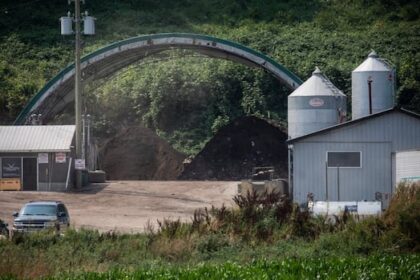SaskatchewanThe City of Saskatoon says a new bylaw banning people from feeding wildlife has drastically reduced coyote sightings in the city; 214 were reported in 2024, and only 71 this year.City credits new wildlife feeding banJeremy Warren · CBC News · Posted: Nov 27, 2025 7:44 PM EST | Last Updated: 6 hours agoListen to this articleEstimated 4 minutesThe audio version of this article is generated by text-to-speech, a technology based on artificial intelligence.A still image from a video of a coyote encounter in Kinsmen Park in Saskatoon, Nov. 25, 2025. (Dana Dergousoff/Facebook)A coyote has interrupted Carla Fehr’s evening dog walk almost every night this month.It happens close to the riverbank along the Meewasin Trail near her home in the City Park neighbourhood. She’s walking her chocolate lab Maple and then all of a sudden, a coyote crosses their path.Just this week, she saw it emerge from the riverbank foliage with a goose in its mouth. “It’s kind of fun to see, and it’s the reality of where we live,” Fehr said. “We live along a riverbank that wildlife uses. And the coyote obviously has a good source of food while there are still some geese around.”Fehr said the coyote encounters aren’t threatening but she would want the city to take action if it becomes aggressive.“It didn’t seem that interested in me,” she said. “Of course, as soon as I saw it, I started moving off the trail towards the road where there’s more light as well.”Reports of coyote sightings have increased in recent weeks, according to the City of Saskatoon. A video posted to social media on Nov. 26 shows a coyote with white fur roaming Kinsmen Park near the riverbank.The city has received 71 reports of coyote sightings in the city so far this year, a steep decline from last year, when sighting reports surged to 214. The drop is likely due to the city enacting a ban on feeding wildlife in Saskatoon, said Cate Francis, the city’s park superintendent for biological services and urban forestry.Saskatoon’s riverbank park spaces are filled with wildlife, like this fox Carla Fehr saw near the Broadway Bridge, Nov. 26, 2025. (Carla Fehr/Submitted)“There were several hotspots [in 2024] where we noted feeding of wildlife occurring,” Francis said. “The new no-feeding bylaw appears to have really helped address those issues and get those coyote behaviors back to normal.”Francis said no one has been fined under the new bylaw, but it has helped enforcement. In May, the city amended the Animal Control Act to “prohibit the feeding of wildlife on all public or private property in Saskatoon” (with an exception for above-grade bird feeders on private property).City dwellersPeople should be used to seeing coyotes in the city, said Bonnie Dell, executive director at the Wildlife Rescue Society of Saskatchewan.“I think the alarm comes because it’s the one predator we see here,” Dell said.“They are born and raised in the city. The city noises, the noises people make, the clapping of hands, honking of horns, they’ve heard it their whole life. That’s nothing. That doesn’t alarm them, that’s just part of their environment. They live side by side with us in the city.”When encountering a coyote, don’t run or panic, but make yourself very big, put your arms up and speak in a loud, firm voice, Dell said. Or carry a plastic bag.“When you swoop it through the air, it fills with air and it makes a noise that they have never heard before,” Dell said. “They’ve never seen such a thing and they’re terrified and they take off, and it’s humane. It reinforces not to get close to people, which is important for any urban animals.”The city has posted signs in the City Park neighbourhood to warn people about the coyotes. The city won’t take action until a coyote shows signs of abnormal behaviour.Coyotes are part of the natural ecosystem and help maintain rodent populations, Francis said. “The calls that we’re getting, a lot of them are near natural areas near the river bank and it’s where we expect to see them,” Francis said.“This time of year it starts to get darker earlier, which means you’re walking your dog maybe in the evening. They’re going wider for food because there’s maybe less abundant food or different food sources for them.”ABOUT THE AUTHORJeremy Warren is a reporter in Saskatoon. You can reach him at jeremy.warren@cbc.ca.
Coyote sightings in Saskatoon decline after 2024 surge












